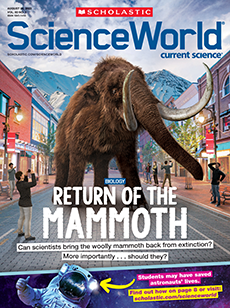Hurricanes are among the most destructive and deadly types of extreme weather. Each year in the U.S., these massive spinning storms cause billions of dollars of damage. Their powerful winds can uproot trees, flatten buildings, and cause devastating floods. Unfortunately, these storms are getting more powerful.
For about 50 years, meteorologists have used the five-point Saffir-Simpson scale to warn of storm threats. This scale ranks storms based on wind speed. A Category 5 rating is given to the strongest hurricanes, those with winds greater than 251 kilometers (156 miles) per hour. But warmer oceans caused by climate change are fueling more-intense storms. That’s why some scientists believe the Saffir-Simpson scale is outdated. “It doesn’t convey the major dangers of today’s hurricanes,” says Michael Wehner, a climate scientist at Lawrence Berkeley National Laboratory in California.
Wehner proposes adding a sixth category to the scale for storms with winds greater than 309 kph (192 mph). Of the hurricanes in the past 10 years worldwide, five storms would have qualified as Category 6 storms.
Even a six-point scale would have limitations. Wehner stresses that it would still only account for hurricanes’ wind speeds—not other deadly risks like flooding. That’s why it’s important for officials to use clear, detailed language and visuals like maps to communicate the true dangers of a storm. “Some people don’t take hurricane [number] warnings seriously,” says Wehner. “That could be a fatal mistake.”
Hurricanes are among the most destructive and deadly types of extreme weather. Each year in the U.S., they cause billions of dollars of damage. These massive, spinning storms have powerful winds. They can uproot trees, flatten buildings, and cause terrible floods. Unfortunately, hurricanes are getting more powerful.
For about 50 years, meteorologists have used the Saffir-Simpson scale to warn of storm threats. This five-point scale ranks storms based on wind speed. The strongest hurricanes get a Category 5 rating. They have winds greater than 251 kilometers (156 miles) per hour. But climate change is warming oceans. That fuels more-intense storms. So some scientists believe the Saffir-Simpson scale is outdated. “It doesn’t convey the major dangers of today’s hurricanes,” says Michael Wehner. He’s a climate scientist at Lawrence Berkeley National Laboratory in California.
Wehner wants to add a sixth category to the scale. It would identify storms with winds greater than 309 kph (192 mph). He researched hurricanes that have formed around the world. In the past 10 years, five of them would have qualified as Category 6 storms.
Even a six-point scale wouldn’t cover everything. It would still only report hurricanes’ wind speeds, Wehner stresses. It wouldn’t include other deadly risks like flooding. That’s why officials need to use clear, detailed language and visuals like maps to warn about a storm’s true dangers. “Some people don’t take hurricane [number] warnings seriously,” says Wehner. “That could be a fatal mistake.”

